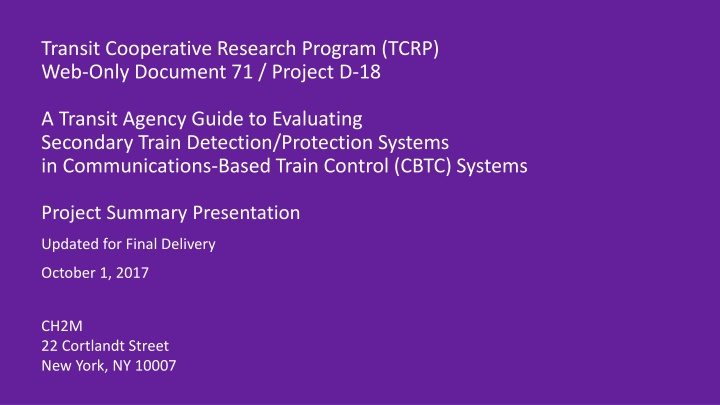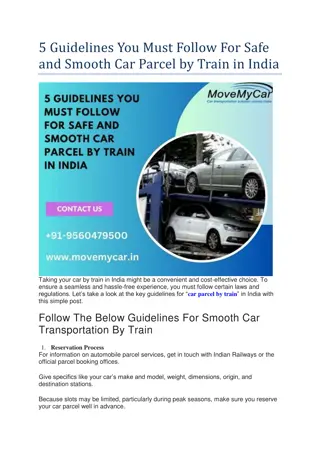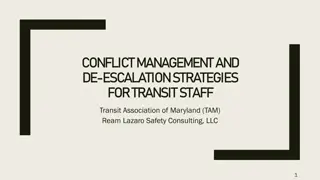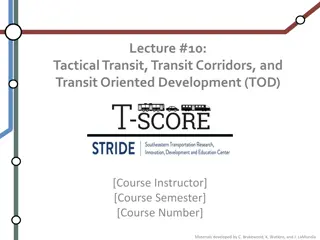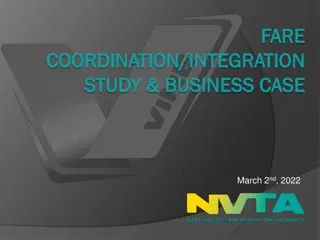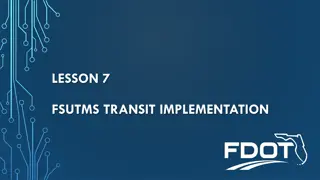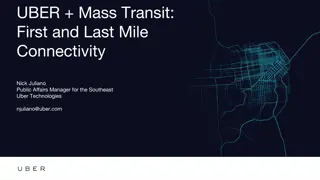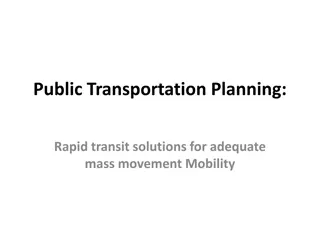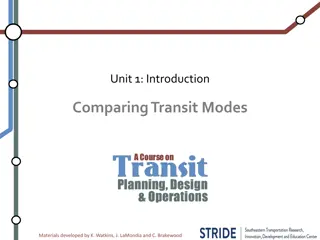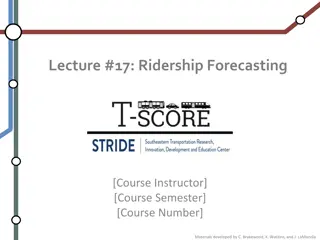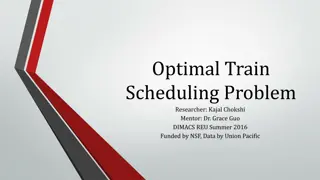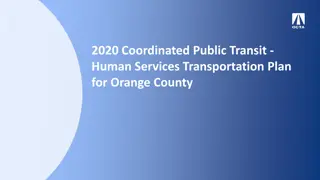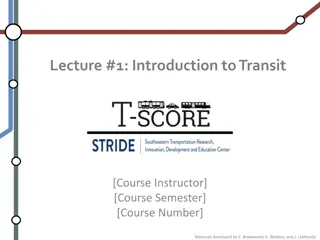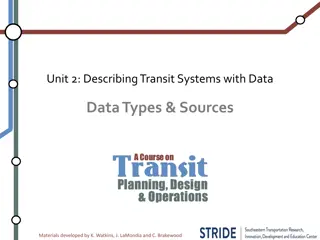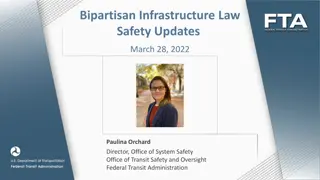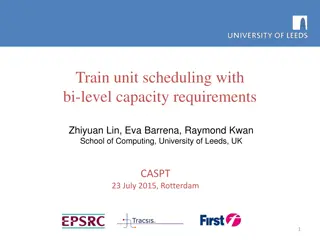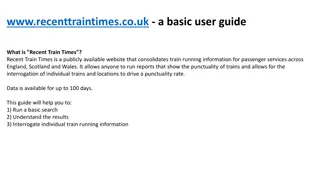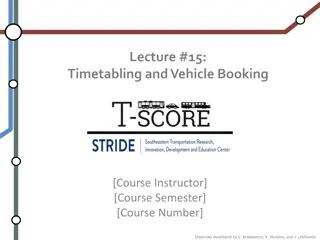Transit Agency Guide for Evaluating Secondary Train Detection/Protection Systems in CBTC
This project conducted by TCRP aims to provide guidelines for transit agencies to evaluate the necessity of secondary train detection/protection systems or alternative operating practices when implementing Communications-Based Train Control (CBTC) systems. The research team at CH2M has been working on various tasks including literature review, industry surveys, case studies, and guide preparation to develop comprehensive recommendations for effective CBTC implementation.
Download Presentation

Please find below an Image/Link to download the presentation.
The content on the website is provided AS IS for your information and personal use only. It may not be sold, licensed, or shared on other websites without obtaining consent from the author.If you encounter any issues during the download, it is possible that the publisher has removed the file from their server.
You are allowed to download the files provided on this website for personal or commercial use, subject to the condition that they are used lawfully. All files are the property of their respective owners.
The content on the website is provided AS IS for your information and personal use only. It may not be sold, licensed, or shared on other websites without obtaining consent from the author.
E N D
Presentation Transcript
Transit Cooperative Research Program (TCRP) Web-Only Document 71 / Project D-18 A Transit Agency Guide to Evaluating Secondary Train Detection/Protection Systems in Communications-Based Train Control (CBTC) Systems Project Summary Presentation Updated for Final Delivery October 1, 2017 CH2M 22 Cortlandt Street New York, NY 10007
Outline of slide deck Outline of slide deck 1. Project Data 8. Task 3: Interim Report (no slides) 2. Research Team 9. Task 4: Case Studies 3. Task 1: Literature Review 10. Task 5: Guide Preparation 4. Task 1: Industry Survey Suppliers 11. Task 6: Technical Memorandum 5. Task 1: Industry Survey Transit Agencies 12. Conclusion 6. Task 1 Summary 7. Task 2: Outline of the Guide 2
Project Data Project Data TCRP D TCRP D- -18 18 Goal: The objective is to conduct industry research, and develop a general set of guidelines to help transit agencies evaluate the need for: 1) Secondary Train Detection/Protection Systems, or 2) Operating practices in lieu of detection/protection systems when implementing a Communications Based Train Control (CBTC) system. 3
Project Data Project Data TCRP D TCRP D- -18 18 Project Phases and Tasks: 2016 2017 Tasks TCRP D-18 Feb Mar Apr May Jun Jul Aug Sep Oct Nov Dec Jan Feb Mar Apr 1 2 3 4 5 6 7 8 9 10 11 12 13 14 15 PHASE 1 TASK 1 / Review Literature and quick agency and supplier survey TASK 2 / Determination of best case study, establish work plan for phase 2 TASK 3 / Prepare an Interim Report PHASE 2 TASK 4 / Conduct case studies TASK 5 / Write a guide for transit agencies about CBTC implementation TASK 6 / Write Technical Memorandum TASK 7 / Produce Final Report 4
CH2M Research Team: CH2M Research Team: David Strong, PE: Project Administrator Girish Ananthashankaran: Project Oversight Kenneth Diemunsch, CSEP: Principal Investigator Stuart Landau, PE: Senior Signal Engineer Muamer Dedovic: Rail Systems Maintenance Expert Robert Spiro (ISR): Rail Operations Specialist 5
Task 1: Literature Review Task 1: Literature Review Relevance to CBTC, STD/PS, broken rail detection Regulations and policies: CFR, FTA, FRA, and TC Standards and recommendations: IEEE, AREMA, UITP, APTA, CENELEC Industry practices: FTA Report 0045, papers and articles, TRB, operating rules, project requirements Broken rail detection Observations 6
Task 1: Literature Review Task 1: Literature Review Regulations and Policies Title 49 CFR section 236 requires track circuits for various reasons. 236.51 requires track circuits to detect trains and broken rails. Title 49 CFR section 236 - subpart I (Positive Train Control) specifically states that Subparts A through H (for conventional systems) must still be followed in the absence of a waiver. Standards and Recommendations Standards exist for both options (with and without STD/PS). Standards and recommendations recognize and support for use of secondary train detection, e.g. IEEE 1474. The AREMA C&S Manual of Recommended Practice has more focus on PTC overlays than CBTC. 7
Task 1: Literature Review Task 1: Literature Review Industry Practice In general, industry studies, papers, and articles produced by suppliers and consultants, lean in favor of newer technologies. Some sources argue against the use of STD/PS, while others present viable factors that justify it as a preferred choice. Summary Outside of the regulatory, standards, and recommendation spaces, it is difficult to find any literature that advocates the use of STD/PS with CBTC. 8
Task 1: Literature Review Task 1: Literature Review Summary Table: Use of STD/PS and conventional practice Regulations and Policies Supported, sometimes required Standards and Recommendations Supported Supported, sometimes required, sometimes discouraged Industry Practice 9
Task 1: Industry Survey Task 1: Industry Survey Suppliers Suppliers Information about the initial survey: Developed and approved by the panel as per TCRP contract Produced a simplified survey version after receiving initial batch of feedback Initial version: about 50 quick questions focused on the secondary system Collected additional information (as new opportunities developed) 10
Task 1: Industry Survey Task 1: Industry Survey Suppliers Suppliers Question # 1 1.1 1.2 1.3 1.4 1.5 1.6 2 2.1 Question Project 1 Project 2 General Information Name of the Agency: Location of the Agency: Number of Lines: Number of Lines under CBTC: Is operation 24/7? CBTC Project Name: General Project Information Was this Greenfield (new line) or Brownfield project (upgrade)? What is the normal modes of train operation in revenue service? - 1. Automatic Train Operation without attendant on board. - 2. Automatic Train Operation with attendant on board. - 3. Automatic Train Operation with driver starting the train after each stop. - 4. Manual Operation protected by the signaling system. - Other (Please describe) CBTC system CBTC Supplier and product name/version: 2.2 3 3.1 Extract of the survey 11
Task 1: Industry Survey Task 1: Industry Survey Suppliers Suppliers Main CBTC Suppliers were surveyed (in alphabetical order): 1. Alstom Transport, St-Ouen, France 2. Ansaldo STS Hitachi, Les Ulysses, France 3. China Railway Signaling Company (CRSC), Shanghai, China 4. Bombardier Transportation, Pittsburgh, PA, USA 5. Siemens Mobility, Chatillon, France 6. Thales Rail Signaling Solutions, Toronto, ON, Canada Additional input from Frauscher Sensortechnik (axle counters) 12
Task 1: Industry Survey Task 1: Industry Survey Suppliers Suppliers Alstom Transport Almost all recent projects feature axle counters: 25 out of last 26 projects Also experience with projects that have track circuits: mostly in the 1990 s and 2000 s One on-going project with no STD/PS: Urbalis 500 in Lille, France, which also features CC to CC data communication. 13
Task 1: Industry Survey Task 1: Industry Survey Suppliers Suppliers Ansaldo STS, A Hitachi Group Company: Systems with both axle counters and track circuits Particularity: On one project where a secondary system was needed, it was decided to use track circuits rather than axle counter for the benefit of broken rail protection. 14
Task 1: Industry Survey Task 1: Industry Survey Suppliers Suppliers Bombardier Transportation: Systems with both axle counters and track circuits 15
Task 1: Industry Survey Task 1: Industry Survey Suppliers Suppliers CRSC: Systems with both axle counters and track circuits, but primarily with axle counters. Almost all greenfield projects. 16
Task 1: Industry Survey Task 1: Industry Survey Suppliers Suppliers Siemens Mobility: Specialized in systems with track circuits (i.e. Paris, New York, Sao Paulo, Algiers) Few recent axle counter projects (i.e. Copenhagen, Riyadh) 17
Task 1: Industry Survey Task 1: Industry Survey Suppliers Suppliers Thales Rail Signaling Solutions: Only signaling supplier with heavy rail projects in revenue service without STD/PS: Vancouver, Kuala Lumpur, JFK all driverless and without STD/PS. Most systems with axle counters and few others with track circuits for larger transit agencies (i.e. Paris, New York, Madrid). 18
Task 1: Industry Survey Task 1: Industry Survey Transit Agencies Transit Agencies Feedback from the following thirteen (13) agencies was received: Revenue Service projects: North America CBTC ongoing projects: 1. New York City Transit Canarsie (L) 2. Transport for London Jubilee and Northern Line 3. BCRTC SkyTrain 4. RATP L1 5. Transport Lausannois M2 6. S-Bane 7. SEPTA 8. JFK AirTrain 1. New York City Transit Flushing (7), NY 2. Port Authority Trans-Hudson, NJ/NY 3. Mass Transportation System, OLRT, Ottawa, ON, Canada 4. Baltimore Mass Transit Authority, MD 5. Bay Area Rapid Transit, San Francisco, CA 19
Task 1: Result of Task 1: Result of Initial Initial Surveys: CBTC Categories Surveys: CBTC Categories Type Category Type Full Secondary System which can Support Revenue Service in peak and/or off peak Peak service Off-peak service Secondary System not designed to Support Revenue Servicein peak and/or off peak but can handle single non-equipped or failed trains Capable of one train per interstation 1.A 1.A.1 1.A.2 Systems with STD/PS 1.B 1.B.1 Capable of one train between two interlockings With detection devices everywhere With detection devices only at interlockings Without territory specific headway performance 1.B.2 1.B.2.1 1.B.2.2 1.B.3 Systems without STD/PS 2 None 20
Task 1 Summary Task 1 Summary Inferences from the initial survey responses: 1. No Greenfield project with a full secondary train detection system has been identified 2. No CBTC projects with a full secondary system using axle counters have been identified 3. No brownfield project without secondary system has been identified 4. Most greenfield projects No secondary system or axle counters as a secondary system 5. Handling work train Axle counters are sufficient, no need to equip trains 6. Broken rail protection Not sufficient to justify a track circuit based secondary system 7. Grade of automation Not direct effect on the secondary system 8. Historical transit agencies Secondary system with track circuits for back-up and for facilitating the transition to CBTC 21
Task 1 Summary Task 1 Summary Inferences from the initial survey responses: 9. High ridership Secondary system for back-up and transition 10. Secondary system Very important for transition to CBTC in brownfield projects 11. For brownfield projects More advanced legacy systems lead to less conservative CBTC system 12. Rubber tire or steel wheel No impact on selection of secondary system 13. Not all suppliers have a product option with project references without any secondary system 14. Recent trend indicates an increase in the use of axle counters as a secondary system in CBTC projects 15. Recent CBTC brownfield projects have been deployed without interruption to revenue service. This might be a reason for increase in projects with axle counters 22
Task 2: Outline of the Guide Task 2: Outline of the Guide Guide Outline 7. Equipment Failures 1. Introduction 8. Work Trains 2. Problem Statement 9. CBTC Category Selection Process 3. List of Acronyms 10. Choosing the Secondary Method of Detection 4. CBTC Technology 5. Secondary Train Detection/Protection Systems (STD/PS) 11. Conclusion 12. Case Studies 6. STD/PS Considerations 23
Task 4: Results from Case Studies Task 4: Results from Case Studies JFK AirTrain Key take away from this case study: Greenfield driverless airport link, started operation in 2003. No secondary detection and protection system. There are CBTC system functions to handle train failures and failed wayside controllers. No broken rail incidents since introduction to passenger service, largely because of specific system characteristics and due to effective preventative rail inspection program. Reliable wayside controller (VCC) drives system availability figure, and operations of control loops. A feature to CBTC system has been added which allows a restart of all trains back to ATO mode immediately after VCC reboot/recovery. 24
Task 4: Results from Case Studies Task 4: Results from Case Studies JFK AirTrain Key take away from this case study: Recovery of failed trains is handled through operating procedures and with use of some CBTC features. However, handling of halted trains using those two is not as efficient as the use of secondary system. Despite the regular maintenance efforts, carborne CBTC equipment failures are inevitable, though the count is low. JFK has three CBTC equipped trailers which can be attached to the maintenance vehicle before running on the line. The trailers provide detection (localization of the train) but no protection (no enforcement of MAL or speed). JFK AirTrain Summary: In summary, the JFK AirTrain has been operating safely and efficiently from its opening date without any type of secondary train detection and protection system. Operating procedures and CBTC features are in place and used when there is a train failure. 25
Task 4: Results from Case Studies Task 4: Results from Case Studies BCRTC Key take away from this greenfield driverless case study: Onboard CBTC system includes high redundancy to mitigate carborne related CBTC failures. The legacy cars feature two fully redundant Carborne Controller (VOBC) per married pair, typically operating in two or three married pair configuration. BCRTC is implementing a new function to CBTC to mitigate the VCC failure recovery process (similar to the one at JFK AirTrain). Work trains are not equipped with any kind of CBTC. This seems to work as work trains are used only during off revenue service hours. Broken rail inspection is conducted by regularly scheduled inspection program. In addition, prior to start of daily service, a slow moving sweep trains are used to sweep the guideway track and visually check for any anomalies. Though the sweeps are not strictly dedicated to detect broken rails, they play an important role in the broken rail protection program. Also note that running rails are replaced every 25 years. 26
Task 4: Results from Case Studies Task 4: Results from Case Studies BCRTC Key take away from this greenfield driverless case study: Without STD/PS, having clear procedures and following them is extremely critical. Indeed, potentially unsafe ATS operator errors on a system with STD/PS could be prevented. This is different for a system without STD/PS, especially for a driverless one. BCRTC Summary: BCRTC is content with the choice of signaling technology and CBTC architecture. The fact that it is a greenfield driverless project which closes at night appears to be the key for having a CBTC system without STD/PS. Absence of STD/PS is not a problem given the system s high redundancy, adherence to procedures and shutdown of service at night which allows maintenance crews/ cars access to mainline. 27
Task 4: Results from Case Studies Task 4: Results from Case Studies NYCT Key take away from this case study: NYCT wanted a fallback system due to very high ridership. NYCT experience with track circuits is good, there was no question regarding the equipment used for the secondary method of detection. NYCT performed its first CBTC project as a pilot project on a low ridership line, prior to deployment on other lines. Based on this experience, the CBTC architecture with track circuits based secondary system was found to be appropriate and hence carried over on other lines. Migration strategy was a big part in choosing CBTC and the CBTC architecture. Intermediate cutover allows to maintain the same level of capacity as before CBTC, until CBTC is stabilized. 28
Task 4: Results from Case Studies Task 4: Results from Case Studies NYCT Key take away from this case study: Restricted Authority function allows CBTC operation to continue at restricted speed over failed STD/PS equipment: track circuits, train stops and signals. NYCT will continue to deploy similar CBTC system across its network using track circuits, train stops and signals as fallback system. On one line, STD/PS operates differently depending on the line section: South section: to allow movement/ transfer of non-equipped trains between yards and different lines, the STD/PS relies on Auxiliary Wayside Signals (capable of supporting revenue service headway). North section: Handles failed trains using Block Signal, but not revenue service. On another busier line, STD/PS was designed to provide degraded revenue service. 29
Task 4: Results from Case Studies Task 4: Results from Case Studies NYCT Summary NYCT opted to retain track circuit based full secondary system as a fallback to CBTC project. Given the very high ridership, the agency needed a full fallback system which would allow revenue service to resume uninterruptedly in case of CBTC failures. The agency is quite familiar with track circuits operations and maintenance, and has no issue with keeping them as part of the new signaling system. Even though the CBTC architecture integrates a full secondary system (track circuits, train stop and signal), the fallback is the same on all currently equipped CBTC lines, though the extent of the STD/PS capabilities is not the same. Interlocking and CBTC projects were separately completed. NYCT CBTC specification calls for both full STD/PS, capable of revenue service headway, or reduced STD/PS. This allows NYCT to adapt to situation given the area specifics, and also to modify the STD/PS as needed in the future. 30
Task 4: Results from Case Studies Task 4: Results from Case Studies PATH Key take away from this case study: Secondary detection system is based on track circuits. The secondary train detection and protection system is capable of off-peak revenue service. Only peak time would be affected by running on STD/PS. FRA regulation and Broken Rail Detection were the main driver for the selection of track circuits as secondary method of detection. CBTC system will be put in service per section with all trains being equipped and running in CBTC in one section and running without CBTC in other sections. PATH Summary: Though a full STD/PS capable of revenue service is more difficult to deploy and may result in more frequent minor delays, this full fallback system assures PATH that there will be no major delays because of a failed CBTC system in the future, whether it is a failed train or failed wayside equipment. 31
Task 4: Results from Case Studies Task 4: Results from Case Studies Transport for London (TfL) Key take away from this case study: Secondary detection system is based on axle counters. Axle counters are deployed mostly for train failure management. STD/PS was not designed to handle wayside failure and operate revenue service. CBTC availability is very good and proved that there was no need for a STD/PS capable of running revenue service. Though reliable, a function to override axle counters was introduced and TfL considers using less axle counters in future projects. Protection methods such as train stops might also affect overall availability and TfL is reducing their numbers. The new STD/PS was not used during the transition to CBTC. 32
Task 4: Results from Case Studies Task 4: Results from Case Studies TfL Key take away from this case study: Rail issue detection through inspection has been proven to be successful. The new STD/PS was not used during the transition to CBTC. TfL Summary: In summary, CBTC has been implemented successfully and is operated very efficiently using axle counter based STD/PS to handle failed trains on both the Jubilee and the Northern Lines. Though already light, the STD/PS might affect the overall availability of the system and TfL is working on optimizing the number of devices. 33
Task 4: Results from Case Studies Task 4: Results from Case Studies Baltimore MTA Key take away from this case study: Tracking of Maintenance of Way work trains (non-communicating) is mandatory. The MTA opted not to rely on track circuits to monitor/detect broken rail. A proactive approach to rail flaw detection will be a part of the system replacement with the procurement of a detection system, such as ultrasonic inspection. The STD/PS not used to support specific level of backup operations performance, but rather to provide vital train separation for all trains, especially non-communicating trains. Mixed mode of operation between the CBTC trains and the non equipped old trains is a possible mode of operation to facilitate transition to CBTC. The STD/PS will not be designed as a back-up system capable of near peak operation. 34
Task 4: Results from Case Studies Task 4: Results from Case Studies San Francisco BART: (Similar to Baltimore MTA) Tracking of Maintenance of Way work trains (non-communicating) is mandatory. Some of the most used work trains will be equipped, but not all the work trains. The BART opted not to rely on track circuits to monitor/detect broken rail. A proactive approach to rail flaw detection which is already in place will be further developed. The STD/PS need not support a specific level of back-up operations performance, but rather provide vital train separation for all trains, especially non-communicating trains. The STD/PS will not be designed as a back-up system capable of peak or off-peak operation. 35
Task 4: Results from Case Studies Task 4: Results from Case Studies Important Notes: Regularly scheduled inspection programs (ultrasonic and daily sweep) can be very effective means for prevention and detection of broken rail conditions. Systems that operate 24/7 service do not have luxury of shutting down its networks to conduct much required maintenance. In such cases, equipped and non-equipped trains often must share the same track which if not handled correctly could lead to a potentially unsafe situation(s). For such cases, use of STD/PS or system to track work trains, is highly recommended. Every agency has very specific constraints which lead to a specific selection of CBTC architecture. Within a transit agency, there can be different constraints based on the line; or, within a line, there can be different constraints and solutions. Most transit agencies are satisfied with their signaling systems. There will always be new projects without STD/PS, with STD/PS made of track circuits and with STD/PS made of axle counters. From the CBTC supplier survey, the trend in the last decade is to have majority of projects using axle counters. 36
Task 4: Results from Case Studies Task 4: Results from Case Studies Thinking outside the box, discussion with agencies: RFID tags to track unequipped or failed train. Either with tags on the wayside like transponders and communicating system on board the train or tags on the cars and readers on the wayside. Complete separated system to track the non equipped and failed trains, not integrated into the CBTC. Could be using the RFID tag and a separate communication network. Double the CBTC system, rather than having a secondary system, having another CBTC as a backup. 37
Task 4: Results from Case Studies Task 4: Results from Case Studies Major factors to consider: Regulation and policies Handling of failed and non equipped (work or transfer) trains Maintenance practices: impact of closing the system overnight Requirement for back up system: High ridership, narrow platforms, adaptation to new technology Greenfield or brownfield with a migration issue both on the wayside and on the carborne. In particular, the need for mixed mode operation if not all the trains are equipped with CBTC at the beginning of CBTC revenue service. Broken rail detection and agency history with track circuits 38
Task 5: Guide Preparation Task 5: Guide Preparation Final Guide Outline 1. Introduction 2. Problem Statement 3. List of Acronyms 4. CBTC Technology 5. Secondary Train Detection/Protection Systems (STD/PS) 6. STD/PS Considerations 7. Equipment Failures 8. Work Trains 9. CBTC Category Selection Process 10. Choosing the Secondary Method of Detection 11. Conclusion 12. Case Studies 39
Task 5: Guide Preparation Task 5: Guide Preparation An important part of the guide is the decision flow diagrams to help agencies decide their need for: 1. Mixed-fleet operation during the cut-over to CBTC 2. Using the STD/PS as a back-up system: a. Operation at peak headway with the secondary system b. Operation at off-peak headway with the secondary system c. Management of a single train with CBTC failure using the secondary system 3. Handling of unequipped work trains 4. Detection of broken rail by the signal system 40
Task 6: Technical Memorandum Task 6: Technical Memorandum Provide recommendations on how to best put this research s findings into practice. Identify possible institutions that might take leadership in applying the research findings/ products. Identify possible issues affecting potential implementation of research findings/products and recommended corrective actions to address those issues. Recommend methods of identifying and measuring the impacts associated with implementation of research findings/products. 41
Task 6: Technical Memorandum Task 6: Technical Memorandum Provide recommendations on how to best put this research s findings into practice: Engage key stakeholders to increase the likelihood of producing useful research findings. Develop and implement a plan for circulating research findings to key audiences. Advocate to the industry policymakers and stakeholders about research. Engage champions to promote research. 42
Task 6: Technical Memorandum Task 6: Technical Memorandum Identify possible institutions that might take leadership in applying the research findings/products: Transit Agencies Rail Signaling Industry 43
Task 6: Technical Memorandum Task 6: Technical Memorandum Identify possible issues affecting potential implementation of research Transit Agencies: The guide has been reviewed by a panel of experts but not subject to an industry review. Obsolescence: as seen with the recent axle counter trend, technology might evolve quickly and the guide may need to be updated in 5-10 years. Broken Rail: One of the issues of not using track circuits is to justify that rail inspection is sufficient. Success of alternatives to track circuits are to be investigated and presented to the industry. 44
Task 6: Technical Memorandum Task 6: Technical Memorandum Recommend methods of identifying and measuring the impacts associated with implementation of research findings/products: Measuring impact of a guide is challenging The following are two ideas: Check if it is referenced in external documentation (papers, reports, etc.) Perform surveys of the transit agencies which decided to choose CBTC technology. 45
Conclusion Conclusion Completed tasks: Task 1: Review literature and industry survey Task 2: Determination of best case studies, plan for Phase II, guide outline Task 3: Prepare an interim report Task 4: Conduct case studies Task 5: Write the guide for transit agencies Task 6: Write the technical memorandum Task 7: Produce the final report 46
Conclusion Conclusion Key take-aways: CBTC system is possible without STD/PS or with minimum level of STD/PS. The minimum level of STD/PS is desirable to avoid adverse effects on CBTC deployment and maintenance/operation. Each agency needs to perform its own assessment. The guide was developed to provide the criteria for each decision. 47
